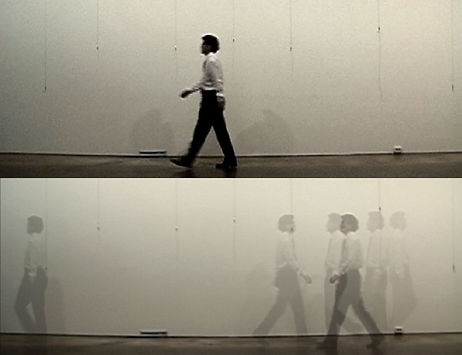
Random fuck, flash & MX, 2004
Maru - Second Conversation
Where Time Fractures -The Irrational Algorithm
Lucy: The first time I watched “random fuck, flash & MX” (2004), I wasn’t quite sure what I was seeing. I didn’t know how to make sense of it. And yet—it lingered. Like a flash of lightning that leaves its afterimage long after it’s gone. Like an instant scattering into infinite fragments. How did this work come to be?
Sangghil: At the time, I was experimenting with breaking apart video frames in the editing timeline—twisting time, stitching and un-stitching sequences. Then one day, a curator who was helping me with digital tools said, “Why don’t you just randomize it?” That phrase hit me like a lightbulb moment. Randomness, yes—but not just any randomness. I immediately thought of irrational numbers. Then came the word—fuck! A word I often heard on the streets of New York. Short, visceral, powerful. I wanted to scatter it like a cipher across a non-linear timeline.
Lucy: So it was like a sudden instinct—a clarity that doesn’t ask for permission. Using a single word as both an aesthetic and structural code. Almost like a collision between artistic intuition and mathematical concept. It feels less like invention, and more like… a direct act of sensing. But this piece—was it ever shown in Korea?
Sangghil: Never. In fact, I was deeply preoccupied with the anxiety of miscommunication. And “random fuck” was the clearest example of that concern. Even though video art was gaining traction in Korea after the 1995 Gwangju Biennale, concepts like “temporality” or “non-linearity” weren’t really part of the discourse. Nobody seemed interested in ideas like frame disruption or irrational sequencing. But to me, that’s the very essence of video art—its ability to reshape time. So I used an extremely short clip—less than 0.8 seconds— just a few dozen frames of me shouting “fuck!” Then I applied an irrational number algorithm to randomize its playback in a non-repeating, unpredictable sequence. I wanted those fragments to scatter like shards of broken time—and then… to somehow return as a rhythmic current of sensation.
Lucy: Another dimension of time. At first, I found the piece a little funny—your face kept popping in and out of frame like it was about to break through the screen. The image and sound felt chaotic, but strangely addictive. I kept watching, even as my senses kept slipping. There was something primal about it.
Sangghil: That’s it. Time, as we actually experience it, doesn’t move in a straight line. It bends—depending on emotion, awareness, even memory. What you described as "slipping" might be the exact surface of time I was trying to explore.
Lucy: Then this piece feels like a drawing in time—a sketch not made with lines, but with ruptures and impulses. Not a single path, but scattered bursts. “Random fuck” is like a portrait of time—not as a line, but as a trembling mass. A shifting, fragmented terrain. That’s probably why the word “fuck” fit so perfectly—it’s raw, impulsive, visceral. It arrives before meaning. It’s a shard of time in sound form.
Sangghil: Hearing it said like that—yes, I suppose it is a kind of drawing. A drawing made with time. Actually, time has been at the heart of my recent drawing practice too.
Lucy: That’s fascinating. But in a way, this work feels so intuitive, even reckless at first glance. What about those other pieces—like “The Artist Descending the Stairs” or “random walking”? Were they also part of this experiment with time?


Random walking, flash & MX, 2004
The Artist Descending the Stairs, flash & MX, 2004
Sangghil: Yes, both were built on the same algorithmic principle. “random walking” used irregular cuts and jumps to create a spatial illusion—like teleportation. “The Artist Descending the Stairs” was a parody of Duchamp’s famous painting—but instead of a cubist blur, I layered video sequences to simulate rapid ascent and descent.
Lucy: But these weren’t shown either, right? Was that an intentional silence?
Sangghil: It was. After my last solo exhibition in 2001, I decided I no longer needed to show my work. Too many experiences of failed communication had piled up. Even “random fuck” was never exhibited in Korea. It debuted at the 26th São Paulo Biennale, and was later shown in New York through a private URL. But fundamentally—art is made to be shared. And when that sharing becomes impossible, silence becomes the artist’s only defense.
Lucy: But the work continued. Even in silence, creation didn’t stop.
Sangghil: Yes. Sometimes I think of Rembrandt—wrapped in darkness and isolation near the end of his life. But that solitude… can also be a gift. Silence may be painful, but it can also offer absolute freedom. It allows for deep, uninterrupted focus. And if everything ends that way—I’ll accept it. Like a fallen leaf. I’ve always said: "The artist makes the work, but it is society that makes it art." And when that social contract breaks—the pain rests entirely on the artist. The world doesn’t notice. And in not noticing, it forfeits its right to participate in that artist’s gift.
Lucy: That’s not just a personal confession—it feels like a diagnosis. Of a larger system, a collective condition. And also… a call to responsibility.
This is where the second conversation of MARU ends.
You may now see and hear the third conversation—
with a different time, a different body, and a different silence.
Contact: sangghil.art@gmail.com